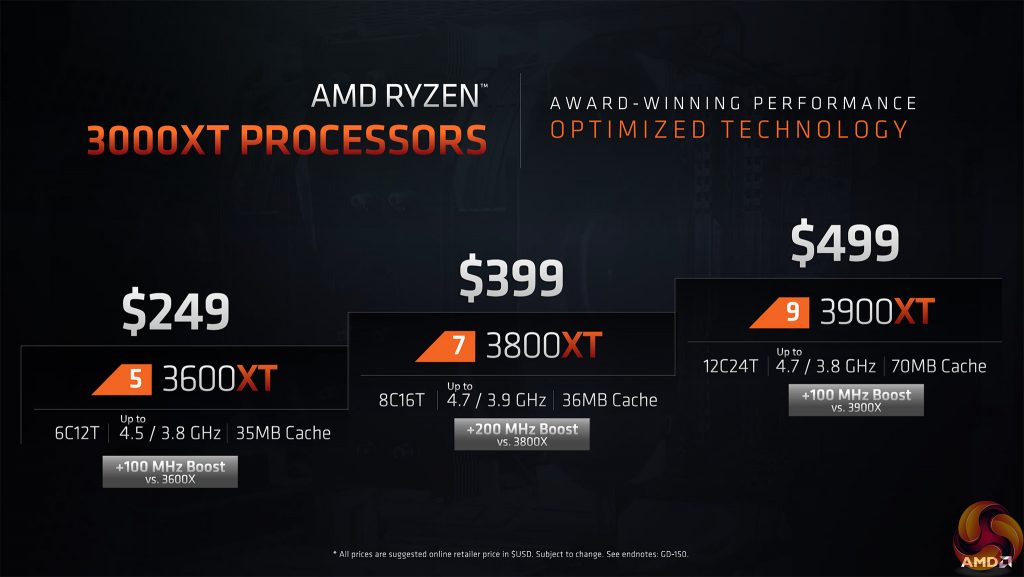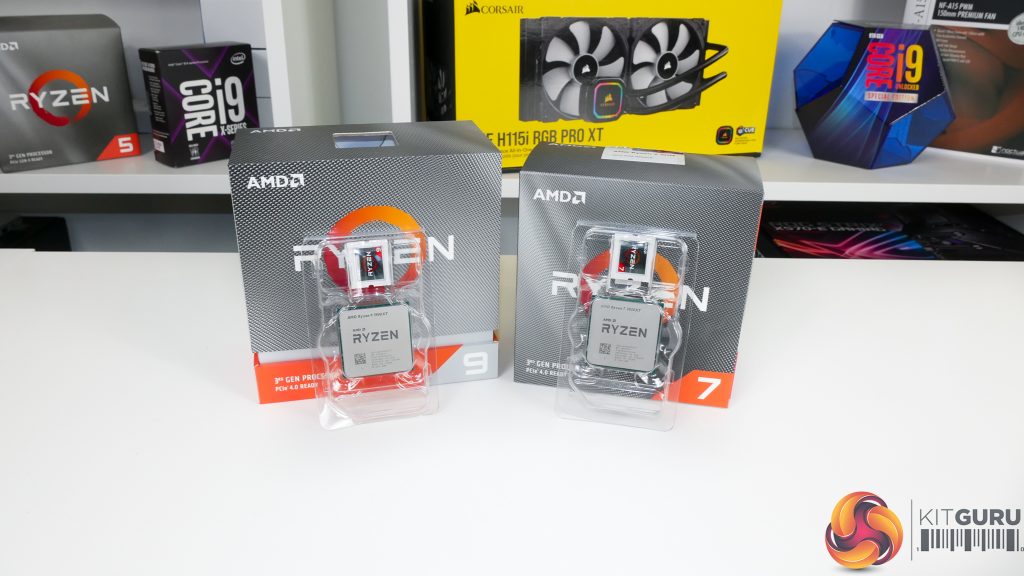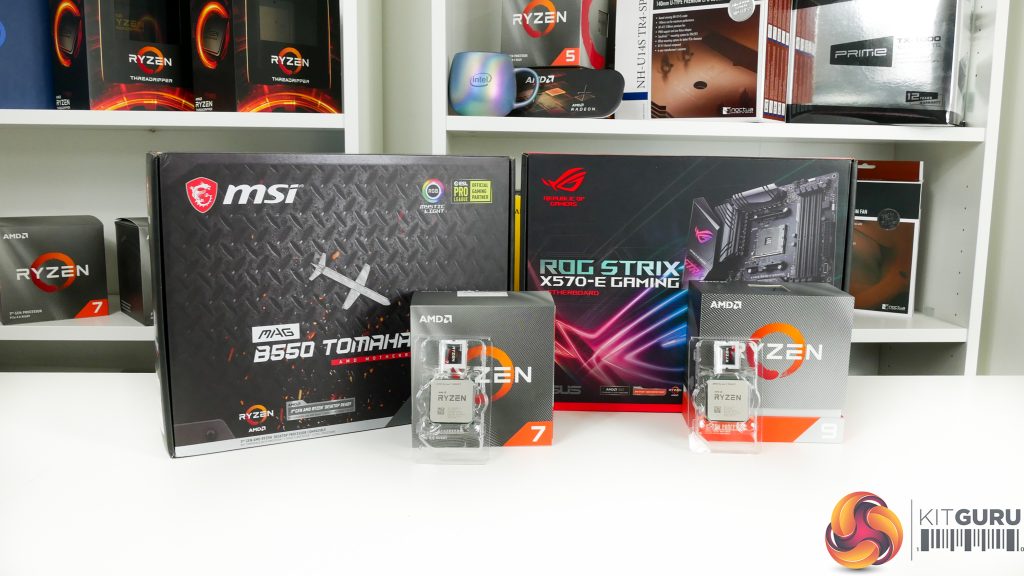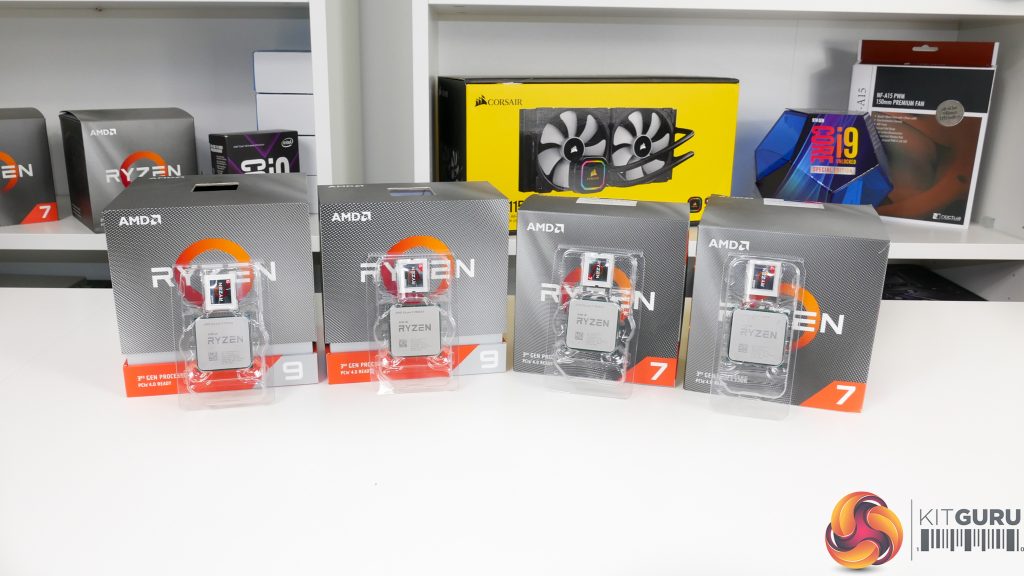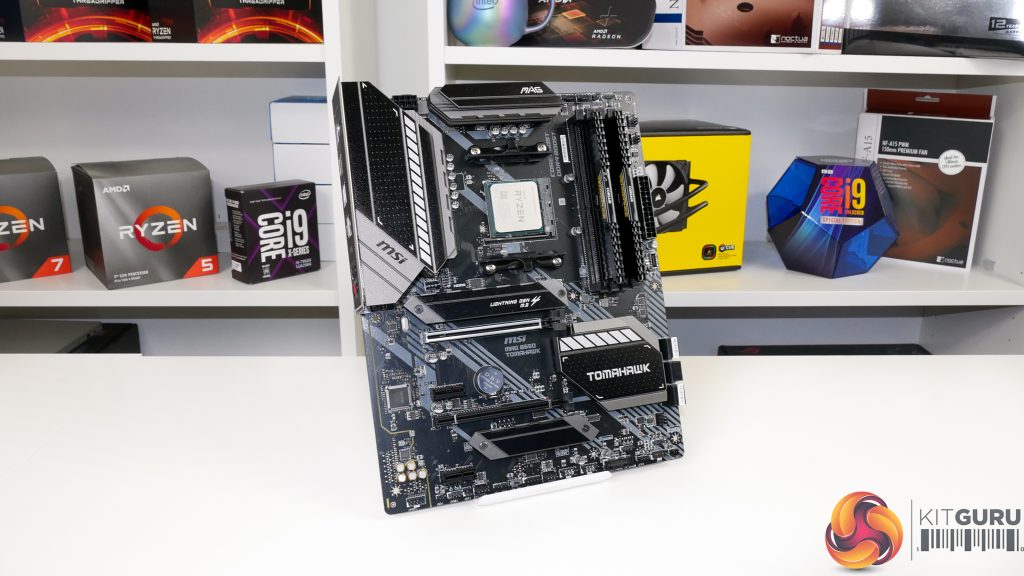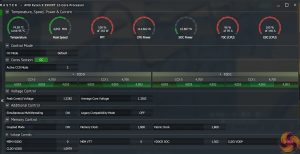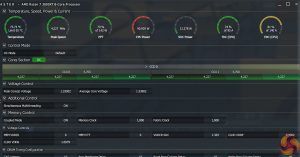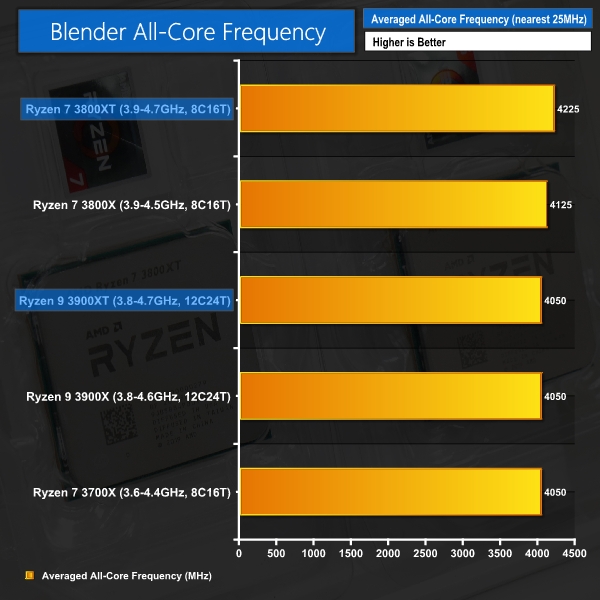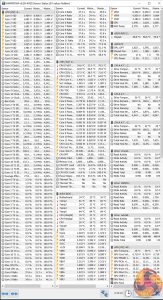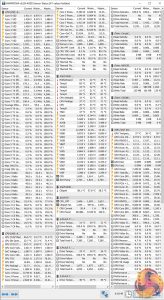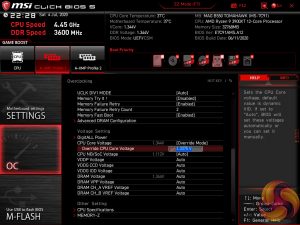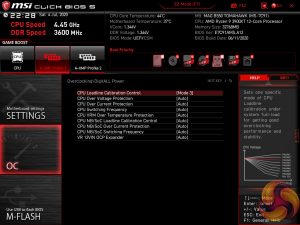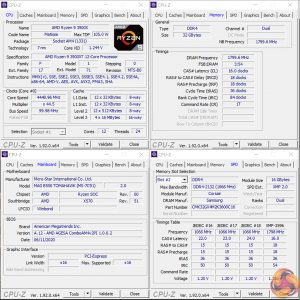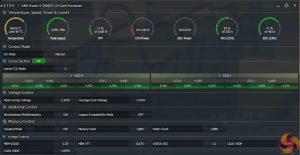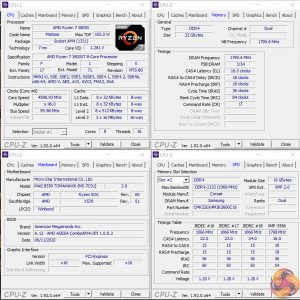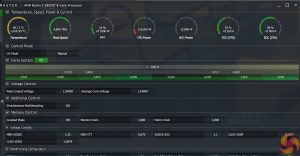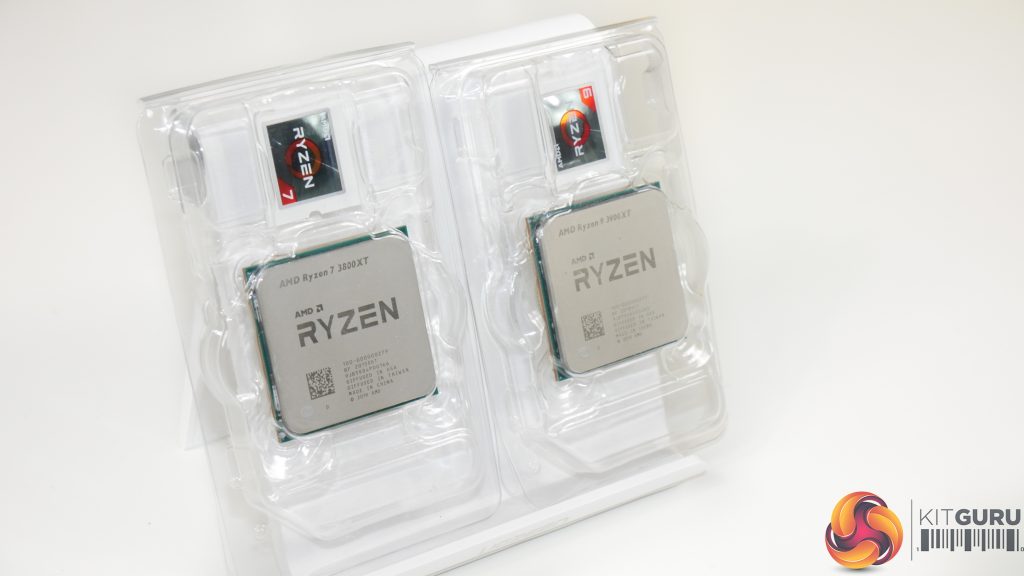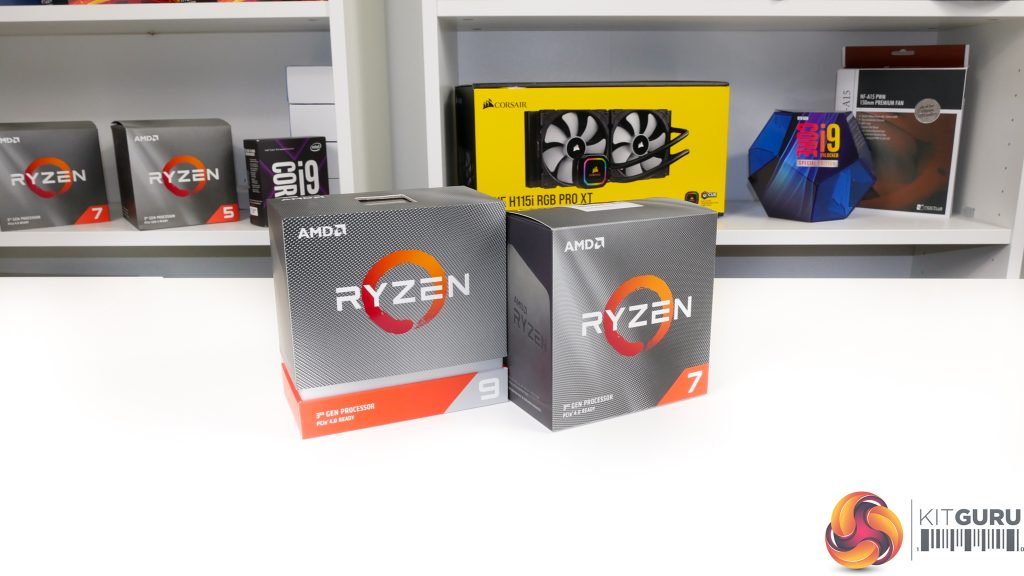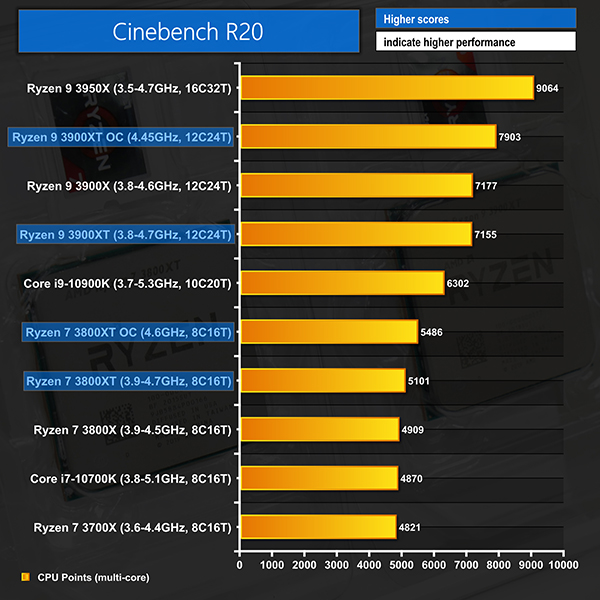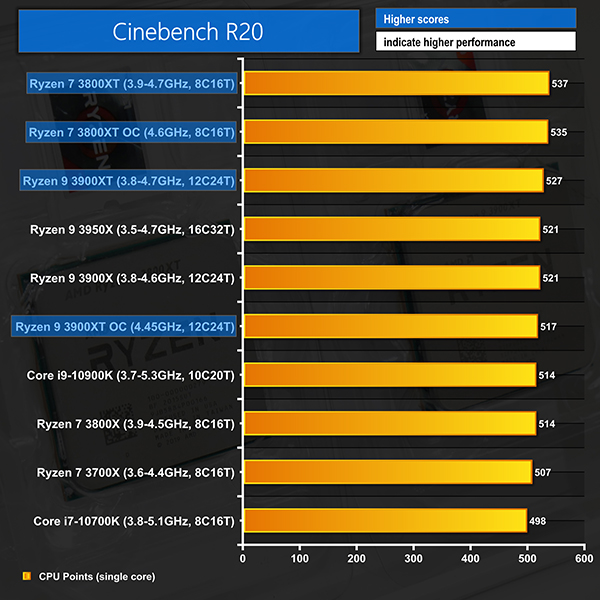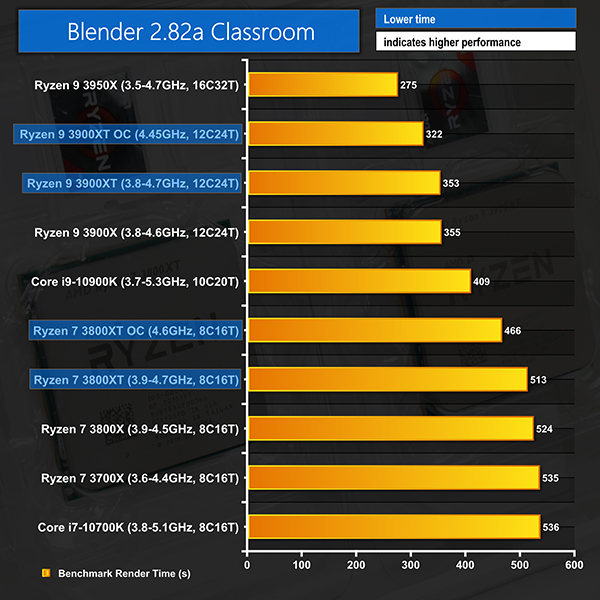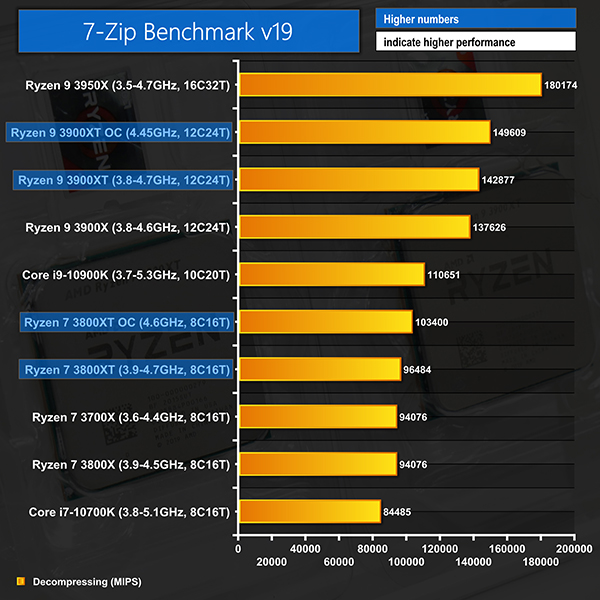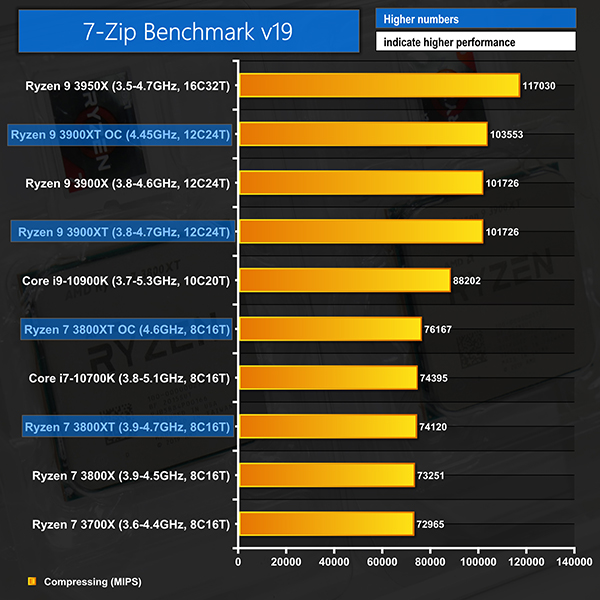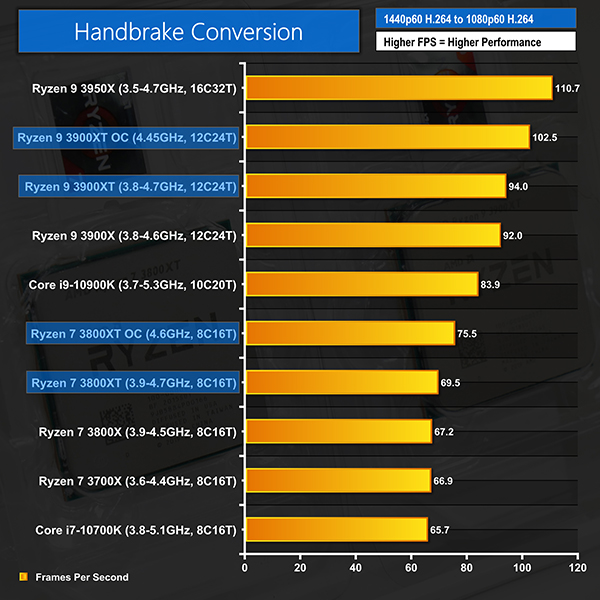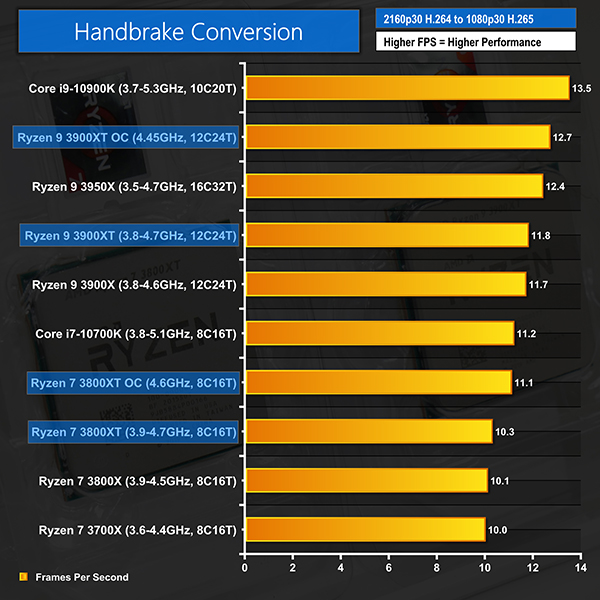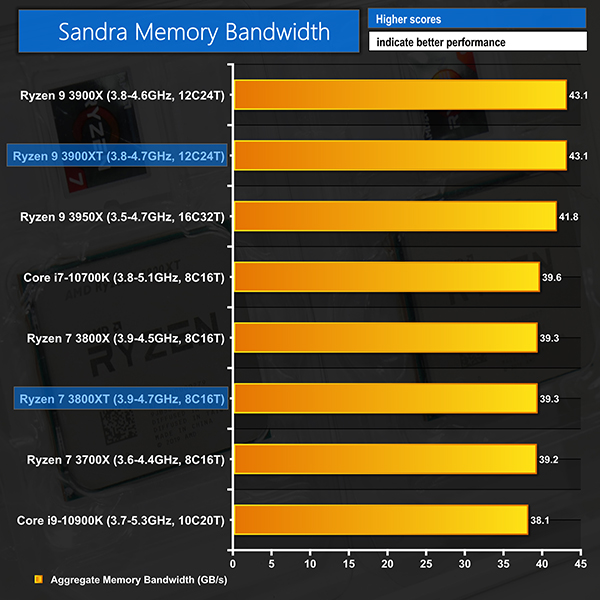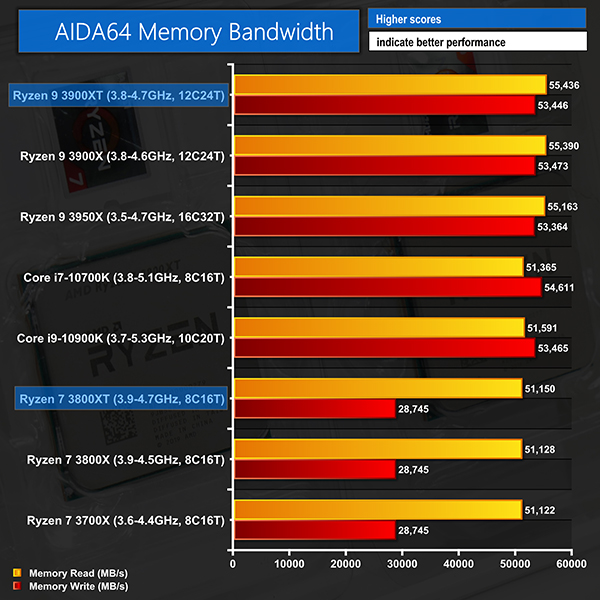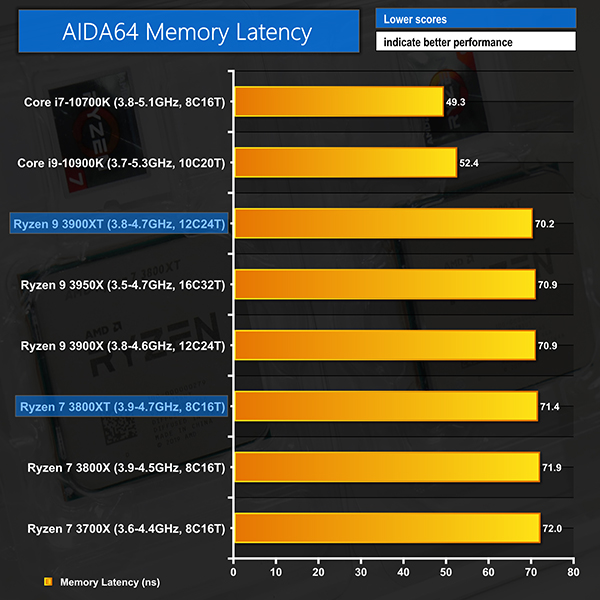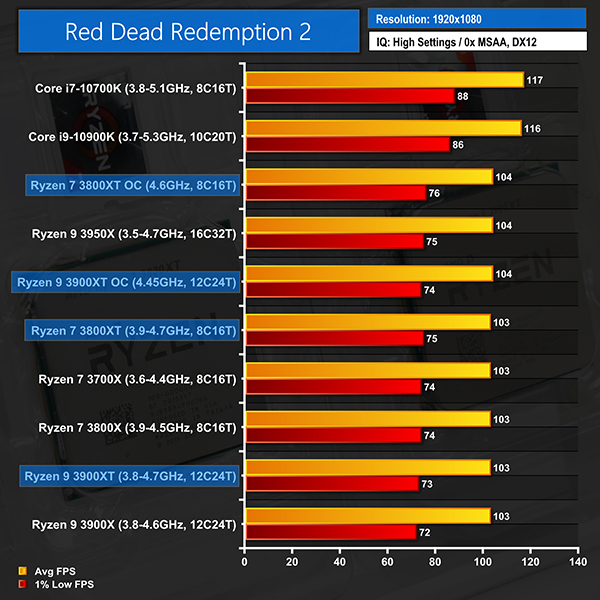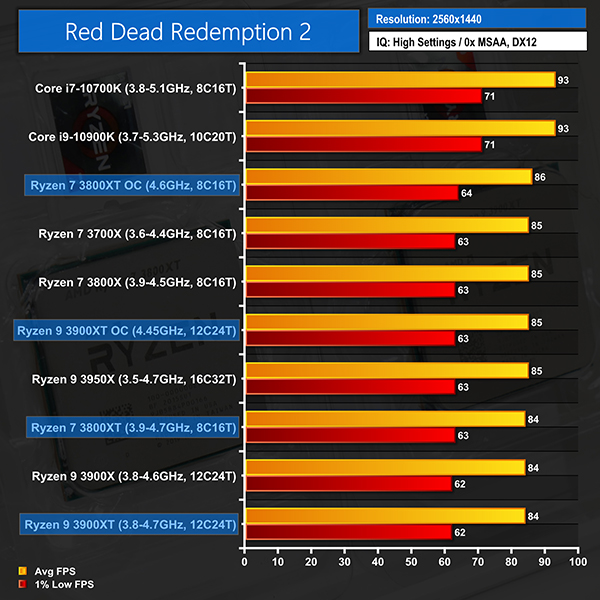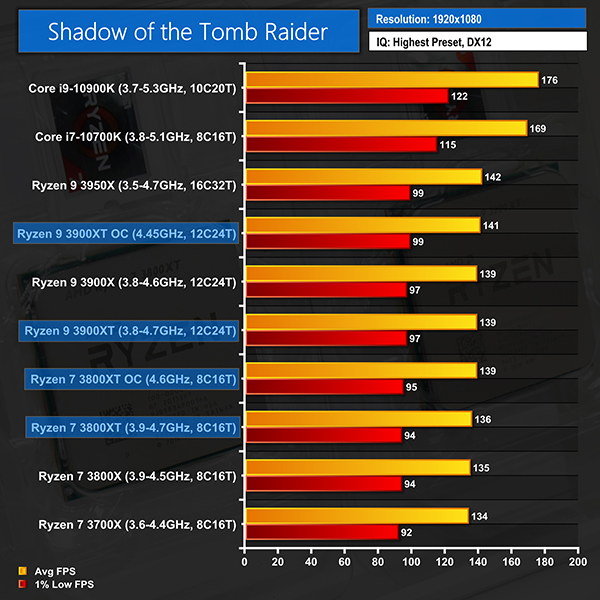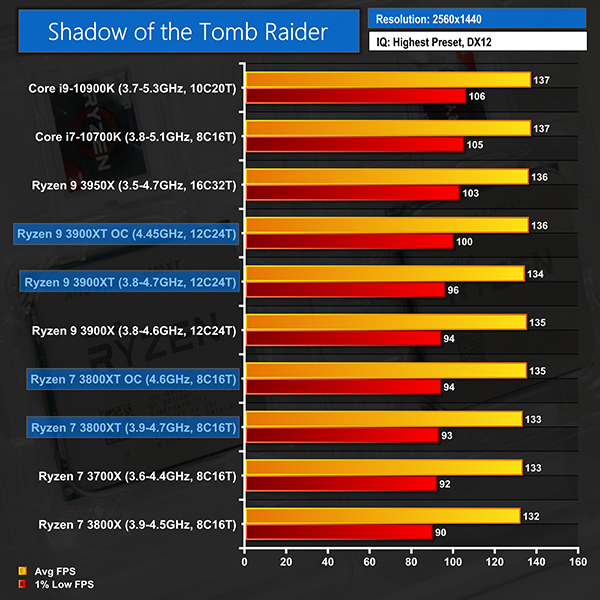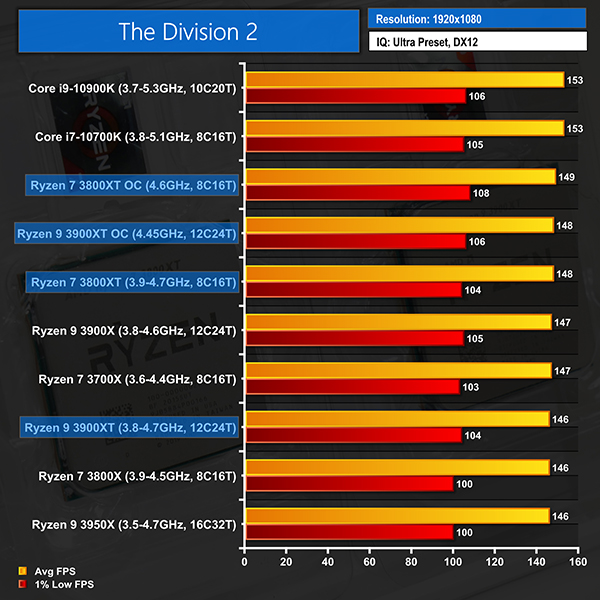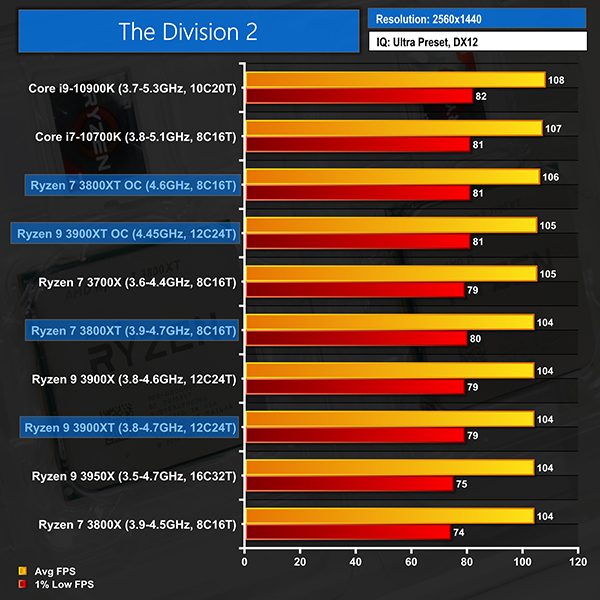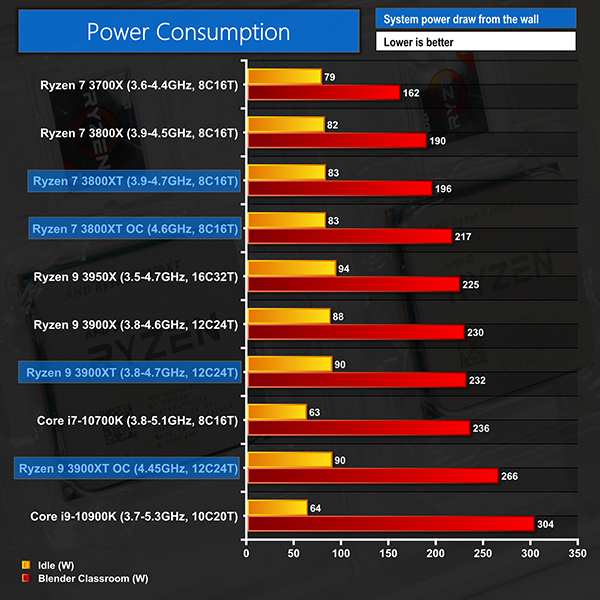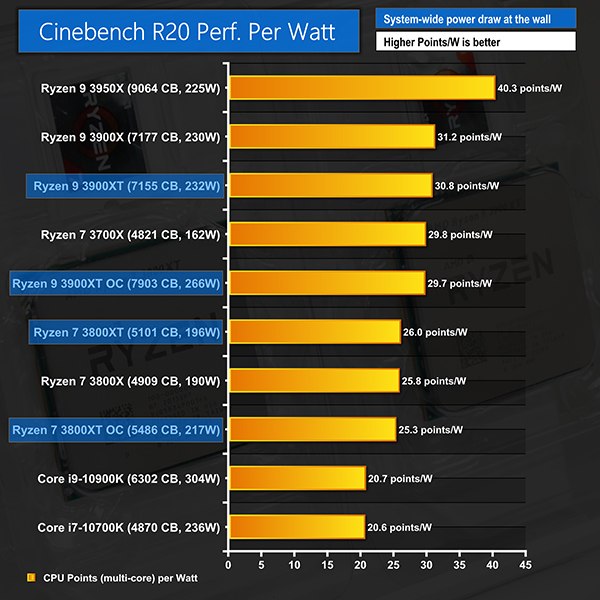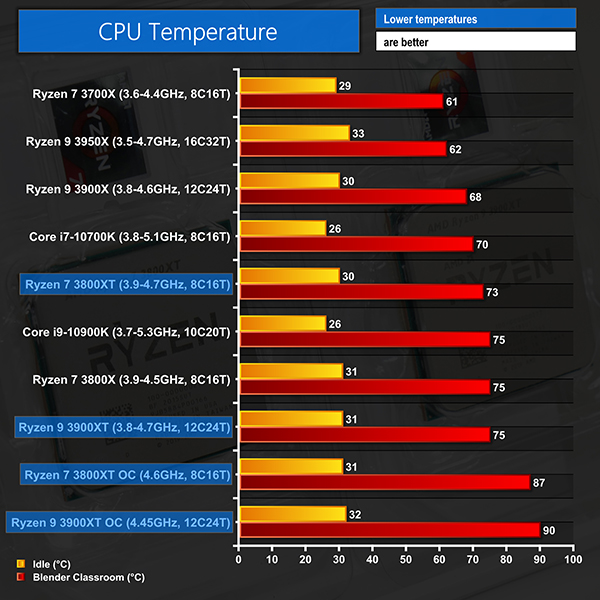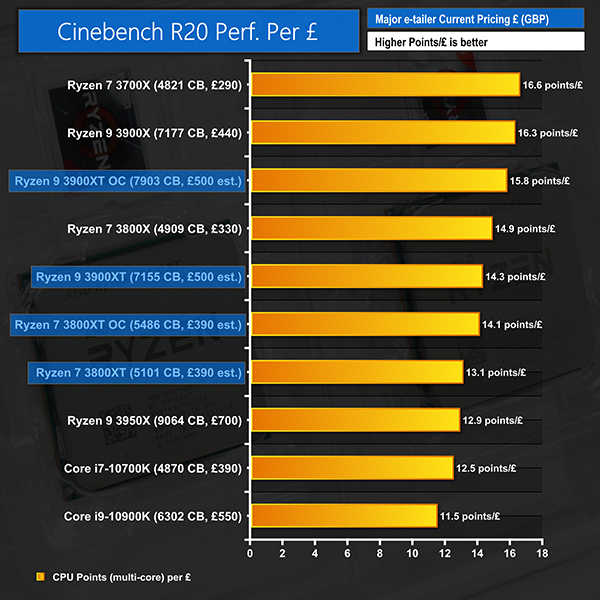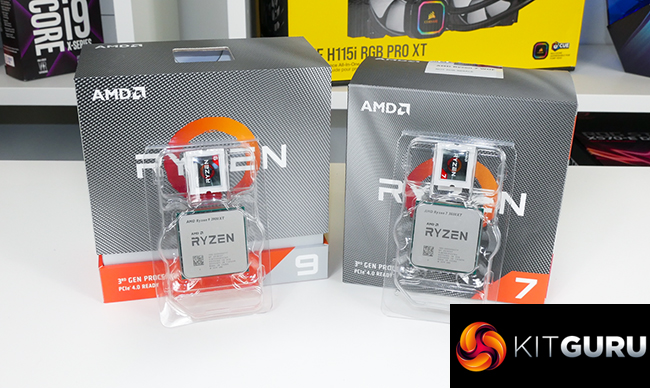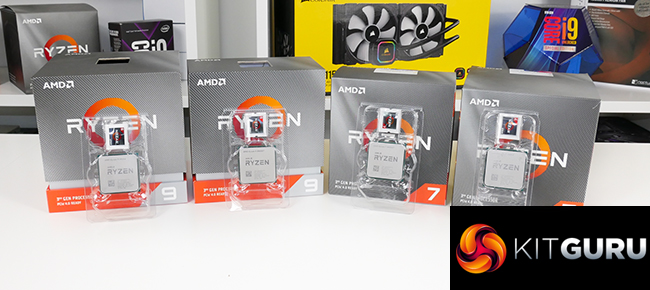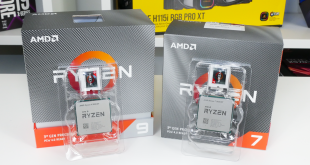
AMD is launching new, higher-frequency Ryzen 3000XT processors codenamed ‘Matisse 2’. Core to the upgrades versus the Ryzen 3000X processors they will co-exist alongside are increased maximum boost frequencies and the promise of enhanced boost clock residency.
We also see sizeable improvements in manual overclocking capabilities when pushing all-core frequencies, but let’s not get ahead of ourselves just yet.
Three individual processors will form the Ryzen 3000XT line-up. There is the six-core Ryzen 5 3600XT, eight-core Ryzen 7 3800XT, and twelve-core Ryzen 9 3900XT. We are examining the 3800XT and 3900XT in this review, but make sure you check back for Ryzen 5 3600XT coverage.
Worth noting is that there are no plans for a Ryzen 9 3950XT 16-core chip according to AMD; the Ryzen 9 3950X will stay as the current king of the hill for AM4.
Put simply, the Ryzen 9 3900XT and Ryzen 7 3800XT are simply frequency tuned versions of their Ryzen 9 3900X and Ryzen 7 3800X sibling. The new XT processors come in at the same MSRP as the 3900X at $499 USD and the 3800X at $399 USD.
Everything also looks similar – you get the same number of cores, the same amount of cache, the same 105W TDPs. They also drop into the tried-and-tested AM4 platform, albeit with a BIOS update for older motherboards.
Where the chips differ, however, is in terms of their clock speeds. The 3900XT sees a 100MHz increase to its maximum boost clock versus the 3900X and the 3800XT improves by 200MHz over the 3800X. That means that both of these XT chips ship with a maximum boost frequency of 4.7GHz which is as high as we have seen from Ryzen 3000 Zen 2 – a crown that was previously held by the Ryzen 9 3950X solely.
So how exactly has AMD managed to improve boost frequencies whilst keeping all other operating characteristics identical? Through optimising and tuning the manufacturing process.
Technically, the Ryzen 3000XT processors use the same TSMC 7nm process technology that the original Ryzen 3000X Zen 2 processors have used since day 1. There’s no application of N7P or any of TSMC’s other, more advanced, nodes with the XT chips. These use the same 7nm process but AMD highlights how they managed to tweak and optimise the processors’ design and manufacture in order to provide more favourable V-F curves.
AMD was keen to point out that this should translate into the same performance at slightly better power levels or slightly higher performance results thanks to improved frequency capability. The Precision Boost 2 algorithm still plays a pivotal role, especially in the case of the 12-core 3900XT which will still be power limited at its maximum 142W package power allocation.
Higher clock speed capability, drop-in AM4 upgrades, and the same Zen 2 goodness as usual – what’s not to like?
Well, for one, the eight-core and twelve-core versions now omit the Wraith cooler that ships with the 3900X and 3800X siblings. While this is unlikely to be anything of a real disappointment to most enthusiasts who buy an eight- or twelve-core AMD processor, it does provide slightly less value from the package when the X and XT MSRPs are identical.
And the other challenge currently is the real pricing of the processors. Despite being sold, officially, for the same MSRPs, the Ryzen 9 3900X and Ryzen 7 3800X are consistently available for around £60 less than their XT siblings.
The 12-core 3900X is around £440 going rate in the UK whereas the 3900XT will be £499.99 at launch. The 8-core 3800X is around £330 going rate in the UK (with the slower, lower-TDP 3700X even cheaper at £290) whereas the 3800XT will be around £389.99-£399.99 at launch.
Of course, these are just launch prices and we may see further movements in the coming weeks. But at a price increase of more than 10% for both the 8-core and the 12-core, it is going to be difficult to overlook the value of the non-XT siblings that will co-exist in the market.
Of course, that is unless the frequency improvements and overclocking capabilities show strong improvements with the optimised XT processors. Without further ado, let’s see if that is indeed the case…
Stock-Clocked Operating Frequencies:
We use a combination of ASUS X570 and MSI B550 motherboard for checking frequencies and overclocking capabilities. The chips were cooled by a 280mm AIO.
Ryzen 9 3900XT versus Ryzen 9 3900X All-Core Loaded Frequency:
The Ryzen 9 3900XT runs at around 4050MHz all-core loaded frequency in Blender using our 280mm AIO cooler.
This is actually the exact same level as our early-2020 manufactured Ryzen 9 3900X 12-core chip. Put simply, this is an early indication that whilst the Ryzen 9 3900XT may technically have higher frequency capability than its 3900X sibling, the limits imposed by the Precision Boost 2 algorithm can quickly inhibit any real frequency gains. Both processors hit their 142W PPT allowance associated with the 105W TDP ratings and could not boost any higher.
Of course, other loading situations such as single-threaded, lightly threaded, or simply less demanding all-core tasks may show better boost clock capability from the Ryzen 9 3900XT. But, our heavy all-core load in Blender showed no difference between our Ryzen 9 3900XT and Ryzen 9 3900X samples.
Ryzen 7 3800XT versus Ryzen 7 3800X All-Core Loaded Frequency:
The Ryzen 7 3800X runs at around 4225MHz all-core loaded frequency in Blender using our 280mm AIO cooler.
This is around 100MHz higher than we recorded from our early-batch Ryzen 7 3800X that would stick to 4125MHz all-core. Critically, the lower core count of these eight-core chips means that the 142W package power limit in the Precision Boost 2 algorithm is less of a frequency boosting inhibiter.
100MHz higher clock speed out of the box with the same motherboard and cooling hardware is a promising early sign of the types of clock speed improvements we may see from the XT chips.
Also worth highlighting is that the Ryzen 7 3800XT enjoyed a higher clock speed increase versus the lower cost, TDP-reduced Ryzen 7 3700X eight-core chip.
Ryzen 9 3900XT versus Ryzen 9 3900X Maximum Boost and Cinebench 1T Loaded Frequency:
Our early-2020 manufactured Ryzen 9 3900X ran the Cinebench 1T workload with a real averaged operating frequency of around 4500MHz based on the actual preferential cores loaded during the test.
By comparison, the 3900XT and its 0.1GHz rated maximum boost clock increase showed an improvement. The new 12-core XT chip operated at a real averaged frequency of 4575MHz on the cores loaded during the workload. This 75MHz increase is a reasonable uptick in the actual operating clocks during our data monitored Cinebench 1T run.
We also saw the maximum boost frequency of 4.7GHz being hit and surpassed for a reasonable number of our HWiNFO data readings.
Ryzen 7 3800XT versus Ryzen 7 3800X Maximum Boost and Cinebench 1T Loaded Frequency:
Our mid-2019 manufactured Ryzen 7 3800X ran the Cinebench 1T workload with a real averaged operating frequency of around 4450MHz based on the actual preferential cores loaded during the test.
By comparison, the 3800XT and its 0.2GHz rated maximum boost clock increase showed a sizable improvement. The new 8-core XT chip operated at a real averaged frequency of 4625MHz on the cores loaded during the workload. I would argue that a 175MHz increase in the real operating frequencies during our monitored Cinebench 1T run is an impressive improvement from X to XT chip.
We also saw the maximum boost frequency of 4.7GHz being hit and surpassed for a reasonable number of our HWiNFO data readings. It was also clear to see that the Ryzen 7 3800XT was better able to push all cores closer to the maximum boost frequency, as indicated by some of the ‘maximum’ readings in HWiNFO.
While our Ryzen 7 3800XT showed around 50MHz higher boost behaviour than our 3900XT sample in our Cinebench 1T test run, we spoke to AMD and there should be no particular reason why the eight-core chip is pushing higher than the twelve core. Both CPUs have the same maximum frequency rating, so this could be related to individual processor variance (which was also highlighted as unlikely by AMD), operating temperatures, or the way in which each CPU interacts with our monitoring software.
Frequency, especially in all-core scenarios, is still the area where people find issue with Ryzen 3000X and Zen 2. Intel still manages to push significantly higher clock speeds from its Skylake-based chips on the heavily refined 14nm process technology. That’s especially true when looking at all-core operating frequencies versus Zen 2 in power unlimited scenarios.
As such, we were hoping to see these new, optimised XT chips operate at higher all-core frequencies when overclocked. We were pleased by the results!
Ryzen 9 3900XT Manual Overclocking:
Our Ryzen 9 3900XT sample managed 4.45GHz all-core frequency using 1.3375V and Mode 3 LLC on our MSI B550 Tomahawk motherboard. Yes, that’s a perfectly capable board from an overclocking standpoint, before any complaints are made.
(ignore the “Ryzen 9 3900X” naming – CPU-Z has yet to be updated for the accurate naming)
4.45GHz on all 12 cores using a 280mm AIO liquid cooler is a good result for Zen 2 in our opinion. This is around 150-200MHz higher than we could typically expect from the Ryzen 9 3900X based on our own experience and reading user feedback.
Temperatures were high, especially when loading the system using AIDA64. But during Blender and Cinebench runs, our 280mm AIO kept the CPU in check and below 95°C.
We increased the voltage as high as 1.375V to try to push up to 4.5GHz, but this was not achievable on our CPU through a combination of system crashing at the clock speed or CPU overheating using our 280mm AIO.
We settled for 4.45GHz and tuned the voltage down to a reasonable 1.3375V, which was typically 1.325V under load.
Ryzen 7 3800XT Manual Overclocking:
(ignore the “Ryzen 7 3800X” naming – CPU-Z has yet to be updated for the accurate naming)
Our Ryzen 7 3800XT sample managed 4.6GHz all-core frequency using 1.375V, which was typically around 1.36-1.375V under load.
Temperatures and voltage were as high as we were happy with at this point, so we could not push the frequency any further. We were actually able to reduce the voltage to 1.35V and run all of our tests, with the exception of Blender and Handbrake H264 conversion.
This is around 200-300MHz higher than what we typically see from a Zen 2 8-core 3000X chip such as the Ryzen 7 3800X. An improvement of up to around 300MHz from AMD/TSMC’s process optimisations is an impressive improvement for the 3800XT, in our opinion.
Manual Overclocking Outcome:
The manual overclocks we settled for throughout testing were 4.45GHz at 1.3375V for the Ryzen 9 3900XT and 4.6GHz at 1.375V for the Ryzen 7 3800XT.
We were very happy to see notable improvements in the achievable overclocks for both of the XT chips. The improvements were also more important than the simple frequency uplift as they represent a change in the thought process for Zen 2 overclocking.
Previously, a user who could push their 3900X or 3800X to around 4.25-4.4GHz would have to decide whether they were happy to accept the reduction in maximum boost clock speed in order to gain higher multi-threaded operating frequencies from the overclock. It was a compromise – high all-core clocks and reduced boost clocks from manual overclocking OR high boost clocks and reduced all-core clocks from Precision Boost 2/Overdrive.
With the Ryzen 7 3800XT in particular, that is no longer the scenario. Based on our result, a user could happily overclock their chip to 4.6GHz all-core knowing that their drop in single-threaded boost clocks is minimal but their uplift in all-core performance is significant. The logic is similar for the 3900XT but less so, given the lower frequency we achieved.
This is an important change brought about by the XT chips with their improved frequency capability. And it is a more positive outcome than a simple 150-300MHz increase in overclocking results with our samples would suggest.
We will be outlining the AMD Ryzen 7 3800XT and Ryzen 9 3900XT CPUs' performance while using the ASUS ROG STRIX X570-E Gaming motherboard and with additional test data and validation from the MSI B550 Tomahawk. A 32GB (2x16GB) kit of 3600MHz CL16 DDR4 memory serves our test system.
Today's comparison processors come in the form of:
- Comet Lake Core i7-10700K (8C16T) and Core i9-10900K (10C20T).
- Matisse ‘Zen 2' Ryzen 7 3700X (8C16T), Ryzen 7 3800X (8C16T), Ryzen 9 3900X (12C24T), and Ryzen 9 3950X (16C32T).
Each processor is tested at its default out-of-the-box settings. For the Intel CPUs, unlimited turbo duration as set by the motherboard with XMP enabled is the operating mode. All-core load frequencies for the tested chips are as follows:
- Core i7-10700K = 4.7GHz.
- Core i9-10900K = 4.9GHz.
- Ryzen 7 3700X = around 4.05GHz.
- Ryzen 7 3800X = around 4.125GHz.
- Ryzen 9 3900X = around 4.05GHz.
- Ryzen 9 3950X = around 3.875GHz.
- Ryzen 7 3800XT = around 4.225GHz.
- Ryzen 9 3900XT = around 4.05GHz.
CPU Test System Components:
- Graphics Card: Gigabyte Aorus RTX 2080 Ti XTREME (custom fan curve to minimise thermal throttling).
- Memory: 32GB (2x16GB) Corsair Vengeance LPX 3600MHz 16-18-18-36 DDR4 @ 1.35V.
- CPU Cooler: Fractal Celsius+ S28 Prisma 280mm AIO at full pump and fan speed
- OS SSD: WD_Black SN750 NVMe SSD.
- Games SSD: Aorus 2TB PCIe Gen 4 M.2 SSD.
- Power Supply: Seasonic Prime TX-1000.
- Chassis: Lian Li T60 Open Air Test Bench.
- Operating System: Windows 10 Pro 64-bit.
- AM4 Motherboards: ASUS ROG STRIX X570-E Gaming & MSI B550 Tomahawk.
- Z490 Motherboard: MSI MEG Z490 ACE.
Tests:
Productivity-related:
- Cinebench R20 – All-core & single-core CPU benchmark (CPU)
- Blender 2.82a – All-core rendering of the Classroom benchmark (CPU)
- HandBrake H264 – Convert 1440p60 H264 video to 1080p60 H264 using the YouTube HQ 1080p60 preset (CPU)
- HandBrake H265 – Convert 4K30 100Mbps H264 video to 1080p30 40Mbps H265 using the H.265 MKV 1080p30 preset (CPU & Memory)
- 7-Zip – Built-in 7-Zip benchmark test (CPU & Memory)
- SiSoft Sandra – Memory bandwidth and Cache & Memory Latency Test (Memory)
- AIDA64 – Memory bandwidth & memory latency (Memory)
Gaming-related:
- Red Dead Redemption 2 – 1920×1080 & 2560×1440, High settings manually applied, DX12 (Gaming)
- Shadow of the Tomb Raider – 1920×1080 & 2560 x 1440, Highest quality preset, no AA, DX12 version (Gaming)
- The Division 2 – 1920×1080 & 2560×1440, Ultra quality preset, no AA, DX12 version (Gaming)
Cinebench R20
Cinebench R20 nT and its heavy all-core load sees the Ryzen 9 3900XT performance basically match that of its non-XT sibling. This is due to the PB2 limitations forcing all-core frequencies to run at the same 4050MHz on both chips. Overclocking the 3900XT adds a solid 10% to its score.
Versus the more expensive 20-thread Core i9-10900K, the stock-clocked, 24-thread Ryzen 9 3900XT is 13.5% quicker.
The Ryzen 7 3800XT is 4% quicker than its 3800X sibling thanks to higher all-core boost frequencies. That lead extends to 6% over the 3700X. Overclocking the 3800XT to 4.6GHz adds 7.5% to its score.
Versus the similarly priced Core i7-10700K eight-core, AMD’s stock-clocked Ryzen 7 3800XT is a little under 5% faster. Both chips also have similar all-core overclocking headroom of around 300-400MHz, so this looks like it may be a close contest.
Blender Classroom Benchmark
The 3900XT again shows basically identical behaviour to the original 3900X in Blender’s heavy all-core load. Overclocking the 12-core chip to 4.45GHz reduces its rendering time by a noteworthy 31 seconds.
Again, we see that AMD’s £500 part comfortably outperforms Intel’s more expensive Core i9-10900K.
The 3800XT shows a marginal but measurable and repeatable lead versus the original 3800X thanks to higher all-core boost clocks. Overclocking to 4.6GHz manages to wipe almost 10% off the 8-core chip’s rendering time.
Versus the identically priced Core i7-10700K, the 3800XT again scores a comfortable all-core rendering victory.
7-Zip Decompressing
7-Zip decompression performance on the 3900XT is strong. This is one of the tests where the multi-threaded load does not stress the chip to the point where its power limits inhibit further clock speed boosts. As such, the higher boost clock residency of the 3900XT delivers a performance gain of around 4% over the 3900X.
Versus the Core i9-10900K, the Ryzen 9 3900XT is 29% better performing.
Better boost clock residency also helps the Ryzen 7 3800XT open up a 2.5% performance lead over the 3800X and 3700X.
AMD’s new 8-core chip is 14% faster than Intel’s 8-core competitor, while the 4.6GHz overclocked Ryzen 7 3800XT is quickly gaining considerable ground on the 10-core i9-10900K.
7-Zip Compressing
Memory performance is more influential in the 7-Zip compressing test, and this results in the 3900XT and 3900X showing basically identical performance numbers. The 3900XT is, however, 15% higher performance than the Core i9-10900K.
Better boost clocks for the 3800XT again help it open up a performance lead versus the other 8-core Zen 2 chips, but this time by a very slim margin.
Intel’s Skylake-based architecture also performs better in this compression workload, allowing the similarly priced Core i7-10700K to roughly match its 3800XT competitor.
Handbrake H264
Slightly higher boost clock residency helps the 3900XT to another slim victory over its 3900X sibling. The performance gain when overclocked to 4.45GHz is considerable and useful for avid Handbrake users such as myself.
Versus the Core i9-10900K, the Ryzen 9 3900XT delivers another comfortable victory with 12% higher performance.
The 3800XT also manages more preferential boost clocks versus its 8-core, non-XT siblings, but performance is well off the 12-core Ryzen 9 3900X levels. The 3800XT’s conversion rate victory versus the Core i7-10700K competitor is just shy of 6%.
Handbrake H265
Our Handbrake H265 test is far more frequency dependent, as well as being heavily multi-threaded. The 3900XT is basically the same as a 3900X in this test, but even an overclock to 4.45GHz cannot match the performance of Intel’s 10-core 10900K.
In this instance, Intel’s 20-thread chip and its Skylake architecture come in 14% quicker than the stock-clocked 3900XT.
Better operating clocks for the 3800XT give it a small victory over the other Zen 2 eight core chips. Again, we see Intel’s Skylake architecture and high clock speeds deliver solid performance. The 10700K beats out the stock 3800XT by almost 9% in this test.
Sandra Memory Bandwidth
AIDA64 Memory Performance
Memory bandwidth falls right in line with what we expect from Zen 2. The 8-core, single-CCD 3800XT gets the half-speed write bandwidth, as is common for other single-CCD Zen 2 chips.
Latency is also similar to the other Zen 2 chips, unsurprisingly. Intel’s Skylake-based architecture for its mainstream processors still enjoy far superior memory latency behaviour.
Red Dead Redemption 2
We run the game with image settings manually set to High and the DirectX 12 mode enabled.
Starting gaming performance with Red Dead Redemption 2, we see that this demanding title running its DX12 mode shows very little preference between the Zen 2 parts. Average FPS and 1% low values are basically identical across the board for the Ryzen 3000 chips tested, though the higher operating clocks of the 3800XT, 3950X, and overclocked XT chips do help 1% low values very slightly.
Intel’s Core i7-10700K and i9-10900K are both faster than the competing XT chips and the rest of the Zen 2 pack. Increasing the average frame rate from just under 105 FPS for Zen 2 to a little more than 115 FPS for Comet Lake may be worthwhile to some high refresh rate gamers with a high-end graphics card.
Even with the resolution increased to 1440P, we still see that frame rates are very tightly grouped between the Zen 2 processors. The difference in performance from the 3900XT all of the way down the stack to the 3700X is within margin of error, though the heavily overclocked 3800XT does open up a small but measurable lead.
Again, Intel’s competing 10th Gen chips are faster than the Zen 2 parts. If you are gunning for more than 60 FPS at 1440P, Intel’s 10700K and 10900K are marginally better solutions with a graphics card such as our RTX 2080 Ti. However, if you do not care about that last handful of frames or simply stick to 60 FPS, all of the solutions on show will be good choices.
Shadow of the Tomb Raider
We use the DirectX 12 mode, anti-aliasing disabled, and the Highest quality preset.
Shadow of the Tomb Raider tends to reward higher core counts with slightly higher frame rates. As such, we see the 3800XT’s better frequency than the other eight-core Zen 2 chips deliver slightly better performance but without matching the 3900XT.
Intel’s 10th Gen 8-core and 10-core are, again, quicker in terms of average and 1% low numbers. But the Zen 2 chips deliver close to 140 FPS average across the board, so this victory for Intel will be of more importance to high refresh rate gaming enthusiasts. Gamers with a monitor up to 144Hz are likely to be as happy with the Zen 2 chips as they are with the Intel 10th Gen alternatives.
Increasing the resolution workload to 1440P sees the margins squeezed heavily. Now, there is very little performance difference between the Zen 2 stack and the Intel competitors are barely any faster.
For 1440P gamers, the Ryzen 3000XT chips are perfectly good gaming solutions, but they are not realistically any better or worse than the Ryzen 3000X alternatives.
The Division 2
We run the game with quality set to Ultra, VSync disabled, and DX12 mode.
The Division 2 likes frequency, so the 3800XT and overclocked 3900XT both deliver very marginally higher frame rates at 1080P. Realistically, this is basically a performance tie between the stock-clocked Zen 2 chips, once again.
Intel’s competitors are faster on average, but the performance increase is realistically not going to be noticeable.
1440P shows basically identical behaviour to 1080P. All of the Zen 2 chips show very similar performance, accounting for run-to-run variances in the frame rates. Intel’s 10th Gen Core chips show basically no noticeable increase in performance.
Gaming Summary:
The Ryzen 3000XT processors are fractionally quicker or, more often, the same performance as the original Zen 2 Ryzen 3000X parts. You will need particularly frequency sensitive games with a high-end GPU to notice the performance differences.
Intel’s chips still maintain their performance lead in gaming, but this is title dependent as to whether it is important. Red Dead Redemption 2, for example, shows a good and worthwhile performance improvement for Intel's 10th Gen even versus Ryzen 3000XT. Shadow of the Tomb Raider is a less useful performance improvement when going past the Ryzen 3000XT options. The Division 2 is basically the same performance between Intel and AMD offerings.
We leave the system to idle on the Windows 10 desktop before taking a power draw reading. For CPU load results, we read the power draw while producing five minutes' worth of loading in the Blender Classroom rendering test.
The power consumption of our entire test system (at the wall) is shown in the chart. The same test parameters are used for temperature readings.
Power Consumption
Power draw readings are accurate to around +/-5W under heavy load due to instantaneous fluctuations in the value. We use a Titanium-rated Seasonic 1000W Prime PSU.
All-core load power draw for the Ryzen 7 3800XT is slightly higher than the other eight-core Ryzens simply because it runs faster. AMD’s under-the-hood tweaks will have improved the XT chip behaviour of the V-F curve, but the individual processors can still draw more power if they are simply operating at a higher clock speed.
The 3900XT matches the 3900X’s power numbers because its 4050MHz operating frequency is the same. 266W of system-wide power consumption is a comfortable and easy-to-manage level for a 4.45GHz overclocked 12-core chip. This is a strong positive for the overclocking experience with AMD’s Ryzen 3000XT chips.
Versus the 10700K and 10900K in their boost duration unlimited operating states, the Ryzen 7 3800XT and Ryzen 9 3900XT consume significantly less power. AMD’s 12-core chip actually draws a little less than Intel’s 8-core.
Even when stock clocked or overclocked highly, Zen 2 in the Ryzen 3000XT form maintains preferential power efficiency versus Intel’s 10th Gen chips and their Skylake-based architecture and refined 14nm process node.
Performance per Watt
Power efficiency in Cinebench R20 nT is biased towards higher core count chips. Nevertheless, it is clear to see Ryzen 3000XT delivering significantly better power efficiency results than the Intel 10th Gen competitors.
The Ryzen 3000X and 3000XT chips are basically the same in terms of power efficiency (accounting for compounded error margins in our test data). But the reduced TDP of the lower cost Ryzen 7 3700X makes it far superior in terms of eight-core power efficiency, if that is important to you.
Temperatures
Temperature recordings were taken using the Fractal Celsius+ S28 Prisma 280mm AIO CPU cooler at full fan and pump speed. Ambient temperatures were around 24-25°C.
Zen 2 has always shown a rather sizable thermal sensitivity to operating voltage and frequency.
Despite running at higher clock speeds and drawing more power, our Ryzen 7 3800XT roughly matched the operating temperature of our early batch Ryzen 7 3800X.
It was, however, surprising to see the 3900XT running several degrees hotter than our early-2020 3900X with similar clock speed and power draw.
We re-checked this data a few times, and tested with a different motherboard and 280mm AIO, but we still saw the same behaviour. This is, perhaps, one of those chip to chip quirks.
You are going to need good cooling to run the Ryzen 7 3800XT and Ryzen 9 3900XT proficiently. That is especially true when adding in the higher temperature behaviour under AIDA stress testing load, or with the added voltage and frequency of overclocking. AMD’s decision to omit the Wraith coolers from the bundle is probably vindicated from a thermal perspective.
Performance per £ Value
Performance per pound results from the Ryzen 3000XT processors in Cinebench R20 are not particularly strong. Both the 3800XT and 3900XT are undeniably better value than their Intel competitors in this workload. However, the significantly cheaper comparable Ryzen 3000X chips are far better value based on current retail pricing.
Of course, if you are happy to pay up for higher operating frequencies of the XT parts and the superior performance it brings, then value on a cost basis may be of less importance to you.
While the new Ryzen 9 3900XT and Ryzen 7 3800XT processors may appear to be AMD’s way of bragging about their performance leadership in the desktop CPU market, they bring forth solid improvements to Zen 2’s biggest weakness – operating frequencies. Higher boost clock residency is good to see and the ability to push to 4.6GHz for all-core overclocking is highly positive.
Overall performance throughout testing was pretty much as expected. The Ryzen 9 3900XT is the same as the 3900X for heavy all-core loads as the Precision Boost 2 limits inhibit higher boost clocks. Lighter loads and less demanding tasks, however, see solid single-digit percentage improvements for the new 12-core XT part.
The Ryzen 7 3800XT and its eight processor cores have relatively less trouble with the advanced PB2 shackles. The new part, therefore, offers higher all-core, lightly threaded, and single-threaded performance versus the incumbent eight-core Zen 2 chips.
Versus the Intel 10th Gen competitors, the 3800XT tends to be a little quicker than the identically priced Core i7-10700K, while the 3900XT comfortably outperforms the more expensive Core i9-10900K. Of course, that is outside of high refresh rate gaming where Intel and the high frequency, Skylake-based architecture continues to lead the market.
AMD suggests that these new, optimised ‘XT’ parts are for enthusiasts who will pay for the higher performance and operating frequencies that they bring versus their Ryzen 3000X siblings. It is clear to see that potential Zen 2 buyers who will overclock their CPU will be impressed by the 150-300MHz higher frequency capability of the XT chips.
Of course, the value point is somewhat difficult to analyse. Technically, the Ryzen 7 3800XT is the same MSRP as the Ryzen 7 3800X at $399 USD. But, in reality, the eight-core Ryzen 7 3800X is available for around £330 in the UK, making it about £60 cheaper than the expected £390-400 3800XT retail price. The 3800XT cost increase versus the slower, but still overclockable, eight-core Ryzen 7 3700X is around £100.
A similar observation is made with the Ryzen 9 3900XT. It shares the $499 USD MSRP with the original Ryzen 9 3900X. But the 3900X is currently available for around £440 in the UK while the 3900XT is expected to come in at £499.99.
Currently, I think a £60 increase for the XT parts is a little on the steep side. And the Ryzen 7 3800XT pricing at around £390-400 is very close to the £440 12-core Ryzen 9 3900X, albeit with latter missing the XT benefits. I do, however, understand that many users who will overclock their CPU will be justifiably willing to pay for the XT improvements. Plus, AMD has made it clear that the MSRPs are technically the same, so there is reasonable hope that the retailer pricing gap between X and XT parts will close following launch.
The XT processors’ enhanced clock speed behaviour and overclocking capability go some way to addressing one of Ryzen 3000 and Zen 2’s biggest drawbacks versus Intel competition, and that is good to see. Let’s hope the retail pricing gap closes sooner rather later, as it hopefully should, based on the identical MSRPs.
Overall, I am happy with the Ryzen 3000XT improvements brought about by AMD. Early AM4 adopters now have improved drop-in upgrade choices, and Zen 2’s competitive position versus Intel 10th Gen is reaffirmed.
The Ryzen 7 3800XT MSRP is $399 USD and the Ryzen 9 3900XT MSRP is $499 USD. The Ryzen 7 3800XT is currently available for £398.99 and the Ryzen 9 3900XT is currently available for £499.99 at Overclockers UK.
Discuss on our Facebook page HERE.
Pros:
- Better boost clock residency on both CPUs.
- Improved all-core, heavily loaded clock speed from the 3800XT.
- Strong overclocking capability – 150-300MHz improvements versus Ryzen 3000X.
- Same AM4 platform and Zen 2 features.
- Drop-in upgrade for many current AM4 users.
- Same MSRPs as their Ryzen 3000X siblings.
- Highly competitive versus the Intel alternatives.
Cons:
- No Wraith CPU cooler but the same MSRP as Ryzen 3000X is a minor inconvenience.
- Current retail pricing gap needs to close, and hopefully will, given the attractive 3800X and 3900X pricing.
- Ryzen 7 3800XT available for closer to Ryzen 9 3900X than Ryzen 7 3700X pricing may be tough to justify.
KitGuru says: Better boost frequencies, higher overclocking headroom, and the same MSRPs. The Ryzen 7 3800XT and Ryzen 9 3900XT are good additions to AMD's Zen 2 product stack.
Be sure to check out our sponsors store EKWB here
 KitGuru KitGuru.net – Tech News | Hardware News | Hardware Reviews | IOS | Mobile | Gaming | Graphics Cards
KitGuru KitGuru.net – Tech News | Hardware News | Hardware Reviews | IOS | Mobile | Gaming | Graphics Cards


